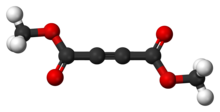Dimethyl acetylenedicarboxylate
Chemical structure of DMADuak
Ball-and-stick model
Names
Preferred IUPAC name
Other names
DMAD
Identifiers
ChEMBL
ChemSpider
ECHA InfoCard 100.010.999
EC Number
RTECS number
UNII
InChI=1S/C6H6O4/c1-9-5(7)3-4-6(8)10-2/h1-2H3
Y Key: VHILMKFSCRWWIJ-UHFFFAOYSA-N
Y InChI=1/C6H6O4/c1-9-5(7)3-4-6(8)10-2/h1-2H3
Key: VHILMKFSCRWWIJ-UHFFFAOYAX
Properties
C6 H6 O4
Molar mass
142.11 g/mol
Appearance
Colorless liquid
Density
1.1564 g/cm3
Melting point
−18 °C (0 °F; 255 K)
Boiling point
195 to 198 °C (383 to 388 °F; 468 to 471 K) (96–98° at 8 mm Hg)
Insoluble
Solubility in other solvents
Soluble in most
1.447
Structure
0 D
Hazards
Occupational safety and health
Main hazards
Toxic
GHS labelling
Danger
H302 , H314
P260 , P264 , P270 , P280 , P301+P312 , P301+P330+P331 , P303+P361+P353 , P304+P340 , P305+P351+P338 , P310 , P321 , P330 , P363 , P405 , P501
Flash point
187 °C (369 °F; 460 K)
Related compounds
Related compounds
Methyl propiolate ,Hexafluoro-2-butyne ,Acetylene
Except where otherwise noted, data are given for materials in their
standard state (at 25 °C [77 °F], 100 kPa).
Chemical compound
Dimethyl acetylenedicarboxylate (DMAD) is an organic compound with the formula CH3 O2 CC2 CO2 CH3 . It is a di-ester in which the ester groups are conjugated with a C-C triple bond. As such, the molecule is highly electrophilic , and is widely employed as a dienophile in cycloaddition reactions, such as the Diels-Alder reaction . It is also a potent Michael acceptor .[ 1] [ 2] nedocromil .
Preparation
Although inexpensively available, DMAD is prepared today as it was originally. Maleic acid is brominated and the resulting dibromosuccinic acid is dehydrohalogenated with potassium hydroxide yielding acetylenedicarboxylic acid .[ 3] [ 4] esterified with methanol and sulfuric acid as a catalyst:[ 5]
Safety
DMAD is a lachrymator and a vesicant .[citation needed
References
^ Stelmach, J. E.; Winkler, J. D. "Dimethyl Acetylenedicarboxylate"in Encyclopedia of Reagents for Organic Synthesis (Ed: L. Paquette) 2004, J. Wiley & Sons, New York. doi :10.1002/047084289X .
^ Sahoo, Manoj (2007). "Dimethyl Acetylene Dicarboxylate" . Synlett . 2007 (13): 2142– 2143. doi :10.1055/s-2007-984894 ^ Bandrowski, E. (1877). "Ueber Acetylendicarbonsäure" . Berichte der Deutschen Chemischen Gesellschaft . 10 : 838– 842. doi :10.1002/cber.187701001231 . ^ Abbott, T. W.; Arnold, R. T.; Thompson, R. B. (1938). "Acetylenedicarboxylic acid" . Organic Syntheses 18 : 3. doi :10.15227/orgsyn.018.0003 Collected Volumes , vol. 2, p. 10^ Huntress, E. H.; Lesslie, T. E.; Bornstein, J. (1952). "Dimethyl Acetylenedicarboxylate" . Organic Syntheses 32 : 55. doi :10.15227/orgsyn.032.0055 Collected Volumes , vol. 4, p. 329




